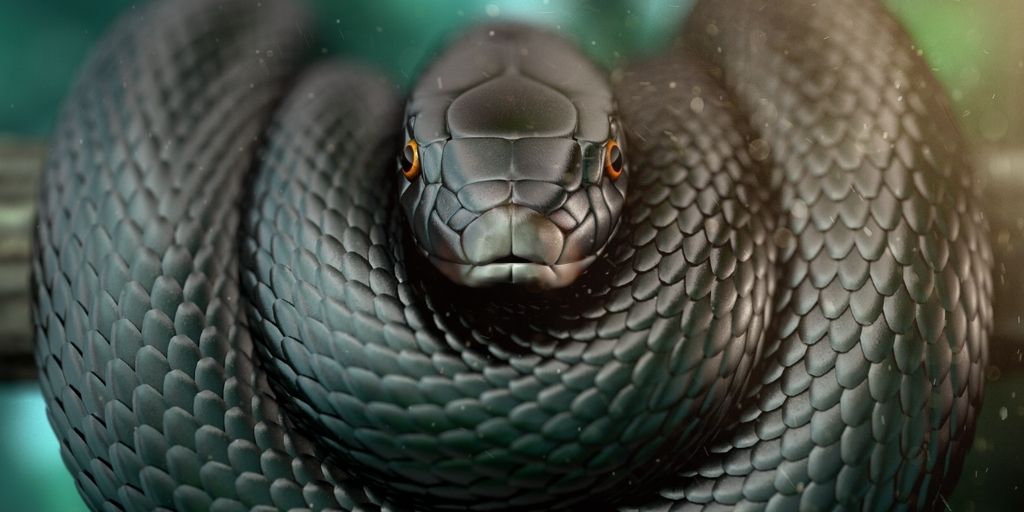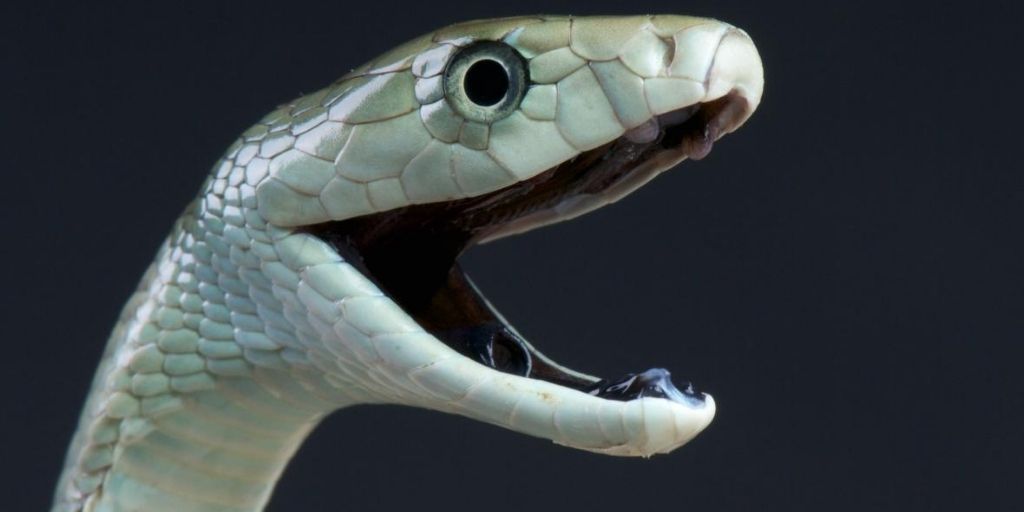The black mamba is a large species of snakes. It is one of the venomous snakes on the planet. Black mambas belong to the family Elapidae. According to Albert Günther black mamba is the second-largest venomous snake after the king cobra. Black mambas generally use their venom to kill prey. However, when they get threatened or concerned by humans they can attack them too. It has been listed as “Least Concern” on the IUCN’s Red List of Threatened Species.
Our wildlife guide to the black mamba covers all the features of this dangerous Serpentes. Let’s quickly get to the sections below for knowing more about the black mambas.

- Latin name: Dendroaspis polylepis
- Family name: Elapidae
- Size: 2-3 meters
- Weight: 6 kilograms
Skip to: Characteristics, Range & habitat, Diet, Behaviour, Fun facts, Video
Black mamba characteristics
Black mambas are long and slender. The body of a black mamba is cylindrical. The length of an adult black mamba ranges from 2 to 3 m. The latest studies reveal that some specimens of black mambas have grown 4.3-4.5 m. Black mambas are front-fanged snakes. Their fangs are close to 6.5 mm. The tail of the black mamba is long and thin. The weight of the black mamba is about 1.6 kg.
Black mambas’ scales have different kinds of shades. Black mambas are yellowish-brown but the color varies. The black mamba has a greyish-white underbelly. The name black mamba is derived from the color of the interior parts of its mouth. It is generally grey or black. Young black mambas’ color is lighter than adults. Their color darkens gradually till their maturity.
Black mambas breed from September to February. The female black mamba lays a clutch of 6-17 eggs. The young’s size ranges from 40-60 mm. They grow quickly and in the first year, they reach close to 2 m in length. The black mambas more or less live 11 years. Some snakes are found to be living for more than 11 years.
Range & habitat
Black mambas live in both the land and the trees. They usually live in abandoned burrows, rock crevices, and cracks in trees. Black mambas are found in the savannas, woodlands, rocky slopes, dense forests of southern and eastern Africa.
They are spread across sub-Saharan Africa. You can find black mambas in the countries like Cameroon, Congo, South Sudan, Ethiopia, Somalia, Kenya, Uganda, Tanzania, Burundi, Rwanda, Mozambique, Malawi, Zambia, Zimbabwe, Botswana, South Africa, Namibia, and Angola. They generally prefer moderately dry environments like light woodland, scrub, rocky regions, semi-arid savanna. It also lives in the moist regions of savanna and lowland forest areas.


Diet
Black mambas are carnivores. They mostly eat little birds or their nestlings and fledglings, rodents, bats, hyraxes or dassies, and lesser bushbabies. Sometimes they feed on other snakes. Black mambas don’t grip the prey after biting. They release the prey and wait for it to paralyze. Thereafter they swallow it.
Behavior & lifestyle
Black mambas are both terrestrial and arboreal animals. When they move on the ground, they keep their head and necks raised. They are diurnal. In South Africa, black mambas bask between 7-10 am and again from 2-4 pm. After warming up they start hunting. They return to the same basking spot daily.
The black mambas are agile and swift in movements. They are unpredictable and often change their direction while moving on the ground. Black mambas can tolerate humans coming closer to it. But it feels safe only if the person is at 40 meters distance. When it senses any threat, it quickly moves into a bush or hole. If it is stopped in the middle of its way, it poses threat to the creature.
The black mamba displays a threat by gaping for exposing its black mouth and continuously flicking the tongue. Like cobras, it also hisses and spreads its neck into a hood while threatened. If the intruder makes any sudden movement the black mamba can bite the person rapidly. In each bite, it can insert a significant amount of venom inside the intruder’s body.
However, a black mamba can raise its head far above the ground. That’s why it can easily bite the upper body of a person. Black mambas are quick in movement. But they can’t exceed their speed above 20 km/h.


Fun black mamba facts
Here is a list of “Top 5 Fun Black Mamba Facts“. You can read it below.
- The venom of black mambas is lethal. The venom starts to damage the nerve tissues within just 10 minutes.
- A black mamba can launch its 40% body length upwards while attacking.
- There is a myth that black mambas are very dangerous animals. It’s not true. They only attack when they are threatened.
- Male black mambas compete among themselves during the mating season. They wrestle and the winner gets the right to mate.
- Black mambas can fully digest their prey in 8-10 hours.
Meet the black mamba
Here at SafarisAfricana, you can read such amazing facts about Safari Animals.
You can read about Most Venomous Snakes In The World here.
You can also read about Fastest Snakes In The World here.
Did you enjoy learning more about the black mamba? Have you ever met this unique creature face-to-face? Tell us about your black mamba experience in the comment section below. Because those who care share!
References
- Haagner, G. V.; Morgan, D. R. (1993). “The maintenance and propagation of the Black mamba Dendroaspis polylepis at the Manyeleti Reptile Centre, Eastern Transvaal”. International Zoo Yearbook. 32 (1): 191–196. doi:10.1111/j.1748-1090.1993.tb03534.x.
- Figueroa, A.; McKelvy, A. D.; Grismer, L. L.; Bell, C. D.; Lailvaux, S. P. (2016). A species-level phylogeny of extant snakes with description of a new colubrid subfamily and genus. PLOS One. 11. pp. e0161070. Bibcode:2016PLoSO..1161070F. doi:10.1371/journal.pone.0161070. ISBN 978-0-643-10674-1. PMC 5014348. PMID 27603205.
- Spawls, Stephen; Howell, Kim; Drewes, Robert; Ashe, James (2017). A Field Guide to the Reptiles of East Africa (2nd ed.). Bloomsbury. pp. 1201–1202. ISBN 978-1-4729-3561-8.
- Marais, Johan (2004). A complete guide to the snakes of southern Africa (New ed.). Struik. pp. 95–97. ISBN 978-1-86872-932-6.
- Mattison, Chris (1987). Snakes of the World. Facts on File, Inc. pp. 84, 120. ISBN 978-0-8160-1082-0.
- FitzSimons, Vivian F. M. (1970). A Field Guide to the Snakes of Southern Africa (Second ed.). HarperCollins. pp. 167–169. ISBN 978-0-00-212146-0.
- “Black mamba”. National Geographic. 10 September 2010. Retrieved 3 December 2010.
- Branch, W. R.; Haagner, G. V.; Shine, R. (1995). “Is there an ontogenetic shift in mamba diet? Taxonomic confusion and dietary records for black and green mambas (Dendroaspis: Elapidae)”. Herpetol. Nat. Hist. 3: 171–178.
- Spawls, Stephen (2010). “Dendroaspis polylepis”. IUCN Red List of Threatened Species. 2010: e.T177584A7461853. doi:10.2305/IUCN.UK.2010-4.RLTS.T177584A7461853.en.
- Håkansson, Thomas; Madsen, Thomas (1983). “On the Distribution of the Black Mamba (Dendroaspis polylepis) in West Africa”. Journal of Herpetology. 17 (2): 186–189. doi:10.2307/1563464. JSTOR 1563464.
- Animal Diversity Web (ADW), University of Michigan
- Hodgson, Peter S.; Davidson, Terence M. (1996). “Biology and treatment of the mamba snakebite“. Wilderness and Environmental Medicine. 7 (2): 133–145. doi:10.1580/1080-6032(1996)007[0133:BATOTM]2.3.CO;2. PMID 11990107.
- “Kruger Park Times – Myths, facts and more about the Black Mamba…”
